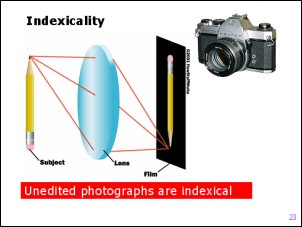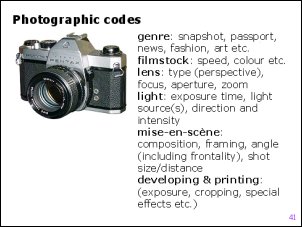Illustrate and critically discuss the transformative role of
some of the key codes which we draw upon in producing and interpreting photographs.
For general guidance about what is expected in your essays for this module,
see the
general criteria.
Please remember to avoid footnotes and to include an
alphabetical list of 'References' which have been cited in the text
(not a Bibliography of anything you have read for the essay). This list should include
author's names, date, book titles (in italics), place of publication and publisher.
Within the text always cite author's surname, date and page number. Double-space your
text and number your pages. For more detailed notes on writing essays in this
department, click
here.
Advice for this particular assignment:
The most relevant lecture for this topic is
Lecture 4: Codes.
Roland Barthes famously observed that photography seems at first sight to be 'a message without a code'.
Since this has been widely misinterpreted what did he mean by this? In Peirce's terms,
photography as a medium is primarily and definitively indexical rather than simply iconic:
it is hardly an accident when photographs 'resemble' what they depict ('OMG - look how much my snapshot looks like the thing I
pointed the camera at - it's uncanny!'), and although photos can be iconic indexes they don't even necessarily
resemble their referents (consider under- and over-exposed photes, oddly frozen action shots, and viewer reactions such as 'that's not a very good likeness'
or 'the mountain seemed so much bigger').
The indexicality of the medium does not mean that transformative codes are not involved.
Which codes are specific to the medium and which are not confined to photography?
Consider the semiotic codes involved in producing photographs
and also those involved when viewers seek to make sense of them. For instance, these codes include (but are far from
confined to) the following:
- representational codes including: technical codes such as filmstock (speed, colour etc.), lens (type, focus, aperture, zoom);
light (exposure time, light source(s), direction and intensity), developing and printing (exposure, cropping,
special effects etc.); aesthetic codes (such as composition or mise-en-scène); genre (snapshot, passport, news, fashion, art etc.);
- social codes including: gesture, posture, expression, clothing and so on.
Even visual forms of communication require codes which are largely shared
by all parties, but do viewers and photographers apply codes differently?
The famous American photographer Ansel Adams declared that
'you don't take a photograph, you make it.'
In what ways does a photograph 'translate' the reality it represents? Most obviously, of course, it
is smaller, bounded, stationary and in two dimensions (all of which deserve comment), but in what other ways does it do so?
Specify as fully as possible the various ways in which
even unedited photographs unavoidably transform the phenomena they appear merely to record. To do this you need to
imagine that you have never encountered photographs before - in exactly what ways are they different from the things they
represent?
Consider a variety of kinds of photography (such as snapshots, ads and
photojournalism) and offer some specific examples in which you analyse in detail the codes employed.
Check your own application of codes against that of others to avoid privileging your own interpretation.
Demonstrate your understanding of relevant semiotic issues and concepts.
Note also that this is an assignment for which the
inclusion of relevant pictorial illustrations is essential. Remember to include a list labelled either Figures or Image sources after your
list of References.
You might find it useful to include and critically discuss several different photographs of 'the same thing'.
Do not get sidetracked into discussing the various ways in which photographs can be edited.
Only some of the books on the suggested reading are explicitly semiotic and you may need to recast their
insights within a semiotic framework.
Some suggested reading
- Alvarado, Manuel, Edward Buscombe & Richard Collins (Eds) (2001)
Representation and Photography: A Screen Education Reader. Basingstoke: Palgrave
- Barry, Ann Marie Seward (1997)
Visual Intelligence: Perception,
Image and Manipulation in Visual Communication. New York: State
University of New York Press
- Barthes, Roland (1977)
Image-Music-Text. London: Fontana
('The Photographic Image' and 'Rhetoric of the Image')
- Barthes, Roland (1982)
Camera Lucida: Reflections on Photography. London: Cape
- Becker, H. S. (Ed.) (1981)
Exploring Society Photographically.
Chicago: Chicago University Press
- Benjamin, Walter (1970 [1935]):
'The Work of Art in the Age of Mechanical
Reproduction'. In
Illuminations (Ed. Hannah Arendt; trans.
Harry Zohn). London: Cape
- Berger, John (1972)
Ways of Seeing. London: BBC/Penguin (not explicitly semiotic but very useful)
- Berger, John (1980)
About Looking. London: Writers & Readers
- Berger, John (1982) 'Appearances'. In John Berger & Jean Mohr
Another Way of Telling. Cambridge: Granta/Harmondsworth: Penguin, pp.
81-129
- Berger, John (2013)
Understanding a Photograph. London: Penguin
- Bolton, Richard (Ed.) (1989)
The Contest of Meaning: Critical
Histories of Photography. Cambridge, MA: MIT Press
- Burgin, Victor (Ed.) (1982)
Thinking Photography. London: Macmillan
- Chalfen, Richard (1987)
Snapshot Versions of Life. Bowling Green, OH:
Bowling Green State University Popular Press
- Chandler, Daniel (1997) 'Visual Perception: Individual Differences,
Purposes and Needs'. [WWW document] URL
http://users.aber.ac.uk/dgc/Modules/MC10220/visper04.html
- Chandler, Daniel (1998) 'Notes on "the Gaze"'. [WWW document] URL
http://users.aber.ac.uk/dgc/media/Documents/short/gaze.html
- Chandler, Daniel (2007)
Semiotics: The Basics (2nd Edn.). London: Routledge
- Chandler, Daniel and Rod Munday (2011)
Dictionary of Media and Communication. Oxford: Oxford University Press
- Clarke, Graham (1997)
The Photograph. Oxford: Oxford University Press;
brief extract 'How Do We Read a Photograph?' [WWW document] URL
http://users.aber.ac.uk/dgc/Modules/MC10220/reading_photos.html
- Elkins, James (Ed) (2007)
Photography Theory. London: Routledge
- Evans, Harold (1978)
Pictures on a Page: Photo-journalism,
Graphics and Picture-Editing. London: Heinemann
- Feininger, Andreas (1974)
Photographic Seeing. London:
Thames & Hudson
- Goffman, Erving (1979)
Gender Advertisements. New York: Harper &
Row/London: Macmillan
- Goldberg, Vicki (1991)
The Power of Photography: How Photographs
Changed Our Lives. New York: Abbeville Press
- Gombrich, Ernst H. (1977)
Art and Illusion: A Study in the Psychology of
Pictorial Representation. London: Phaidon
- Hall, Stuart (1981): 'The Determinations of News Photographs'. In
Stanley Cohen & Jock Young (Eds.)
The Manufacture of News: Social Problems,
Deviance and the Mass Media. London: Constable, pp. 236-243
- Hirsch, Julia (1981)
Family Photographs: Content, Meaning and Effect.
New York: Oxford University Press
- King, Graham (1984)
"Say Cheese!" Looking at Snapshots in a New Way.
New York: Dodd, Mead
- Kress, Gunther & Theo Van Leeuwen (2006)
Reading Images: The Grammar of Visual Design. London: Routledge
- Lutz, Catherine & Jane Collins (1994) 'The Photograph as an Intersection of Gazes:
The Example of National Geographic'. In Taylor (Ed.), op. cit., 363-84
- Messaris, Paul (1997)
Visual Persuasion: The Role of Images in
Advertising. Thousand Oaks, CA: Sage
- Mitchell, W. J. T. (1994)
'Intention and Artifice'. In W J Mitchell (1994)
The Reconfigured Eye: Visual Truth in the Post-Photographic Era.
Cambridge: MIT Press, (Chapter 3), pp. 23-57.
- Mitchell, W. J. T. (1994)
Picture Theory: Essays on Verbal and Visual Representation.
Chicago: University of Chicago Press (Chapter 9: 'The Photographic Essay: Four Case Studies', pp. 281-322)
- Newton, Julianne H. (2001)
The Burden of Visual Truth: The Role of
Photojournalism in Mediating Reality. Mahwah, NJ: Lawrence Erlbaum
- Nichols, Bill (1981)
Ideology and the Image. Bloomington, IN:
Indiana University Press (Chapters 1 & 2)
- Rudisill, Richard (1982): 'On Reading Photographs',
Journal of American Culture 5(3)
- Sanders, Noel (1988): 'Angles on the Image'. In Gunther Kress (Ed.)
Communication and Culture. Kensington, NSW: New South Wales
University Press, pp. 131-56
- Scott, Clive (1999)
The Spoken Image: Photography and Language. London: Reaktion
- Snyder, Joel & Neil Walsh Allen (1975) 'Photography, Vision and Representation', Critical Inquiry 2(1): 143-169.
Reprinted in: Thomas F Barrow, Shelley Armitage & William E Tydeman (Eds) (1982)
Reading into Photography: Selected Essays, 1959-1980. Albuquerque, NM: University of New Mexico Press, pp. 61-91; and
Philip Alperson (Ed) (1992)
The Philosophy of the Visual Arts.
New York: Oxford University Press, pp. 289-305.
- Sobieszek, Robert A. (1988)
The Art of Persuasion: A History of Advertising Photography.
New York: Harry N Abrams
- Sonesson, Göran (1989a)
Pictorial Concepts: Inquiries into the Semiotic Heritage and Its Relevance for the Analysis of
the Visual World. Lund: Lund University Press
- Sonesson, Göran (1989b)
Semiotics of Photography: On Tracing the Index. Lund: Institute of Art History
- Sontag, Susan (1979)
On Photography. Harmondsworth: Penguin
- Spence, Jo (1986)
Putting Myself in the Picture. London:
Camden Press
- Spence, Jo & Patricia Holland (Eds) (1991)
Family Snaps: The Meanings of Domestic
Photography. London: Virago
- Tagg, John (1988)
The Burden of Representation: Essays on
Photographies and Histories. Basingstoke: Macmillan
- Taylor, Lucien (Ed.) (1994)
Visualizing Theory. New York: Routledge
- Trachtenberg, Alan (Ed) (1980)
Classic Essays on Photography. New Haven, CT: Leete's Island Books
- Wagner, Jon (Ed.) (1979)
Images of Information: Still Photography in the
Social Sciences. Beverly Hills, CA: Sage
- Walden, Scott (Ed.) (2010)
Photography and Philosophy: Essays on the Pencil of Nature. Chichester: Wiley-Blackwell
- Wells, Liz (Ed.) (1997)
Photography: A Critical Introduction.
London: Routledge
- Wells, Liz (Ed) (2003)
The Photography Reader. London: Routledge
- Ziller, Robert (1990)
Photographing the Self. Newbury Park, CA: Sage
Note: Treat with extreme caution sources labelled with this symbol!






